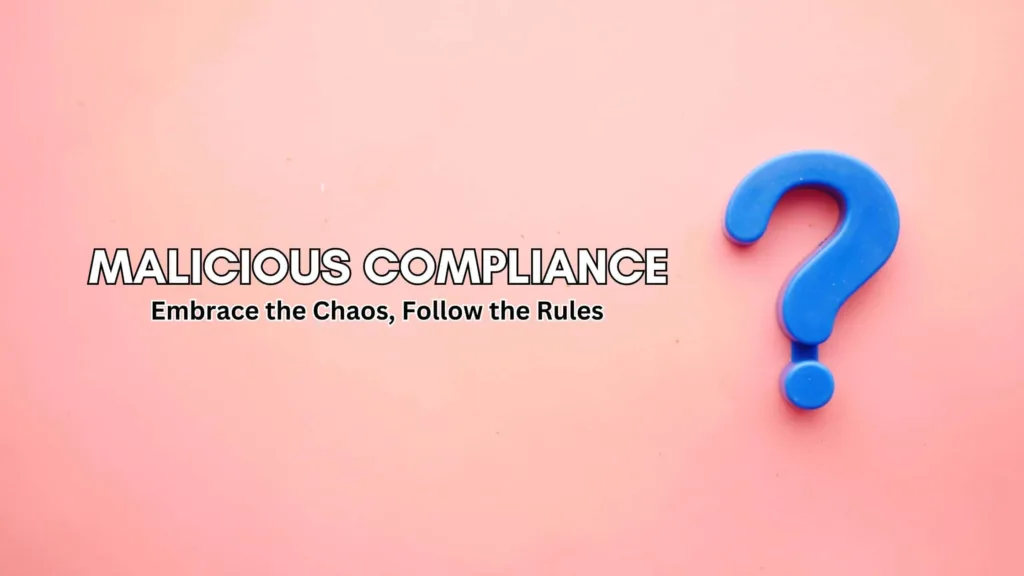Ever heard of “Malicious Compliance”? It’s like when you’re told to do something at work, but instead of questioning it, you follow the rules exactly. But here’s the catch: you’re not doing it to be a good employee – you’re doing it to cause a bit of trouble or to show that the rules don’t make much sense.
It’s a bit like playing a trick. Imagine your boss asks you to do something weird, and instead of saying, “Hey, this is strange,” you do exactly what they say. But deep down, you’re doing it to create some chaos or to point out that the request is a bit silly. This “malicious compliance” stuff shows how things can get a bit messy when people work together.
Origin/Background of Malicious Compliance
Let’s talk about where the idea of “malicious compliance” comes from. Imagine you’re at work, and things are a bit annoying or unfair. Instead of getting all upset, some people decide to be sneaky about it.
So, when they’re told to do something, they follow the instructions super precisely, not because they want to impress anyone but to secretly show how weird or unfair the situation is. It’s like a quiet way of saying, “Hey, this doesn’t make much sense!” This sneaky rebellion is what we call malicious compliance – a way of making a point without making a big fuss.
Related Info: Professional Skepticism: Ethical Decision Making
The Thin Line Between Obedience and Rebellion
Let’s talk about doing what you’re told and doing it a bit differently on the inside. Imagine your teacher or boss gives you a task, and you do exactly what they say, not because you like it, but to make a point. It’s like saying, “It’s like telling them, “Fine, I’ll do it, but I’m not too excited about it.”

This is what we’re talking about when we mention the fine line between obeying the rules and kind of rebelling.
Some Examples
- Imagine your boss gives you a task with a super short deadline that’s almost impossible to meet. Instead of arguing, you decide to finish it on time, but the work might not be your absolute best. It’s like quietly showing that the deadline was too crazy.
- Now, think about a place where everyone has to follow a weird dress code. Instead of complaining, everyone follows it exactly, but they choose the silliest outfits. It’s a way of saying, “It’s like telling them, “Fine, we’ll wear what you want, but we’ll make it fun and silly.”
These examples show how people use malicious compliance to deal with work problems without directly saying, “This isn’t right.” It’s like a sneaky way of pointing out issues.
Impact of “Malicious Compliance” on Workplaces
Let’s talk about what happens to the way people work together when there’s a lot of this “malicious compliance” stuff going on.
When people feel frustrated at work, they might use malicious compliance as a way to deal with it. But here’s the catch – it can cause some issues for how everyone works together. If the workplace doesn’t encourage people to speak up or doesn’t listen to their concerns, you’re more likely to see this sneaky kind of rebellion.
It’s important to figure out why people are acting this way. Is it because they’re not happy with how things are? Understanding these reasons helps make the workplace better and friendlier for everyone. So, fixing the way people communicate and addressing their concerns is a key part of creating a nicer work environment.
Related Info: Trepidation: Whispers Of Fear
The Way Forward/Guide
Let’s talk about what organizations can do when people start acting in this tricky way called “malicious compliance.”
When people are doing this, it’s like a sign that they’re not happy with how things are at work. Instead of just saying, “Oh, they’re just being difficult,” leaders should look deeper. It’s a chance for the boss and others in charge to think about what might be wrong.
Rather than just saying, “Stop doing that,” leaders should take it as a chance to understand what’s really going on. They can figure out the main issues causing frustration and encourage everyone to talk openly about them. This way, they can make the workplace better by getting rid of the problems that lead to this sneaky resistance.
On Top of That
Malicious compliance is like a puzzle in how people act at work. When folks feel frustrated with rules or how things are going, they might start doing this tricky thing called malicious compliance. It happens when they follow the rules but not because they want to be super good – it’s more like they’re trying to show that something isn’t right.
At work, it’s like a dance between the boss and the employees. If everyone wants a happy workplace, it’s important to understand why this tricky behavior is happening. By figuring out the problems and talking openly about them, the workplace can get better. Balancing following the rules and talking openly helps create a nicer place to work where everyone feels heard.”

Pingback: Vicarious Conditioning: Shared Experiences and Understanding
Pingback: Vicarious Reinforcement: Connecting Through Others